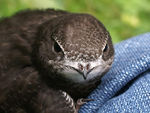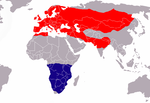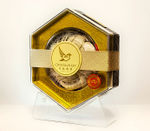Swift
| Swift |
|---|
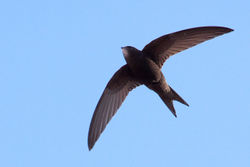
|
| Scientific Classification |
|
| Genera |
|
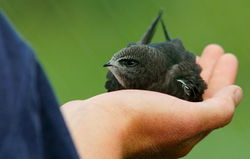
|
| Young swift sits in hand |
swifts are the most aerial of birds. Apodidae comes from the Ancient Greek απους, or apous, which means "without feet", since swifts have very short legs and don't settle on the ground by choice.[3] They spend the majority of their life in the air, and can do many things while flying. This includes eating, drinking, sleeping, and even mating. However, swifts must land for the breeding process.[4]
Body Design
The common swifts are small birds, being 16–17 cm long with wingspans of 38–40 cm, and can weigh 36-52 grams. They have tails that are deeply forked, and swept-back wings that are narrow but long, allowing them to make rapid, sharp turns in the air whilst hunting flying insects.[5]
Swifts' bodies are a blackish-brown color except for their chins, which have a small white or pale grey patch which is not visible from a distance. Their tiny beaks are perfectly adapted for catching flying insects.[6]
Swifts have short forked tails and very short legs that are only used for clinging to vertical surfaces. Because of their long wings and short legs, swifts are unable to walk or take off from the ground. They never settle voluntarily on the ground; swifts are always in the air except for breeding.[7]
Communication between swifts occurs mostly through the use of different vocalizations and by changes in body language. The types of calls used are largely dependent upon a swift's age. The most common call used by adults during flight is a long, shrill ‘sreee’. Some calls also include allopreening (nest-call), those following defeat in a fight (piping-call), and those preceding copulation (sexual intercourse). The most common call used by the young is for when they beg for food from a parent upon its return.[8]
Life Cycle
Common swifts return to the same colonies to mate each year in May and June, which consist of 30-40 couples. Swifts breed and build their nests on cliffs, in caves, and tree holes, as well as in wall cracks and roofs of old buildings. The males usually choose the place to nest. The females lay a clutch of two or three eggs that are laid in a cup-shaped nest. A swift-made nest is typically composed of things such as grass, leaves, hay, straw, and flower petals that are glued together with saliva.[9]
Incubation (the act of incubating eggs, that is, keeping them warm so that development is possible) duties last for 19 or 20 days and are shared by both the male and female. The young are fed by both parents for around 42 days whilst in the nest, with the adults flying as far as 560 miles each day to forage for food.
The common swift is monogamous (the practice or condition of having a single sexual partner during a period of time) and chosen couples breed together for many years. However, if one partner dies, its place is immediately taken by another.[10] It lives approximately 7 years, but a 21 year old common swift was once caught as one of the oldest found.[11]
Ecology
Swifts have an extremely large range, living on all the continents and are widespread in a variety of habitats. However, swifts are most abundant around towns and cities. Swifts in temperate regions are strongly migratory and fly to tropical locations during the winter. Some species can survive short periods of cold weather by entering torpor, a state similar to hibernation. The further north a swift species lives, the darker it will be.[12]
The size of the swift population has probably increased greatly with forest clearing and the availability of urban nesting sites, but its decline has been noted since the 1980s.[13]
Edible Bird's Nest
Edible bird's nests are among the most expensive foods on the planet, costing as much as $4,500 per pound. They are exclusively built by small birds known as swiflets. The nests are built from the bird's salivary secretion which is abundant, particularly during breeding season.[14]
Swiftlets are found in many coastal limestone caves around the Indian Ocean, as well as in South East Asia, Borneo, Malaysia, Indonesia, Thailand, Vietnam, and the Pacific Islands. Their nests, often found clinging to the ceilings of caves as high as two hundred feet, are built by both the female and the male for raising their young. When the hatchlings are ready to fly off, the nests are abandoned.
Removing these nests can be a risky and meticulous job, and, depending on the type of nest, it can take a single person eight hours to clean ten nests.[15]
Some of the most costly edible bird's nests are known as red blood nests. However, many often mistake the red to be from the stains of birds' blood; in actuality their reddish hue is not from blood, and the nests are merely ferrous (containing or consisting of iron) material. The reddish brown color is the result from a chemical reaction between oxygen and iron, with humidity also stimulating the rust to be absorbed into the nest.[16]
Swift Calls
Gallery
References
- ↑ Felipe, Peters. Apodiformes Wiki Species. Web. Last modified October 29, 2015.
- ↑ Species of Swifts Avian Web. Web. Accessed January 9, 2016. Unknown Author.
- ↑ Swifts Avian Web. Web. Accessed February 27, 2016. Unknown Author.
- ↑ Seago, Michael. Swift Birds of Britain. Web. Accessed February 22, 2016.
- ↑ Common swift fact file Wildscreen Arkive. Web. Accessed February 9, 2016. Unknown Author.
- ↑ Gains, David. Swift British Garden Birds. Web. Last update February 21, 2015.
- ↑ Common Swifts Avian Web. Web. Accessed January 9, 2016. Unknown Author.
- ↑ Thompson, Katie. Apus apus common swift Animal Diversity Web. Web. Accessed February 11, 2016 .
- ↑ Thompson, Katie. Apus apus common swiftAnimal Diversity Web. Web. Accessed January 26, 2016.
- ↑ Common swift (Apus apus) Wildscreen Arkive. Web. Last accessed January 27, 2016. Uknown Author.
- ↑ Why we named society "Čiopa" or "Common swift"? Ecological Society Čiopa. Web. Accessed January 25, 2016. Unknown Author.
- ↑ Shipley, Ryan. Heterothermic flexibility allows energetic savings in a small tropical swift: The Silver-rumped Spinetail (Rhaphidura leucopygialis) The American Ornithologists' Union. Web. Accessed January 26, 2016.
- ↑ Alderfer, Jonathan. Chimney Swift Chaetura pelagica National Geographic. Web. Accessed January 26, 2016.
- ↑ Parry, Wynne. Healing Powers of Birds' Nest Soup Remain Mysterious Live Science. Web. July 11, 2012 .
- ↑ King, Chang. [http://www.flavorandfortune.com/dataaccess/article.php?ID=672 Bird's Nest: The Caviar of the East Flavor and Fortune. Web. Accessed February 9, 2016.
- ↑ How Red "Blood Bird's Nest" is formed Chandra Kartika Bird's Nest. Web. Accessed February 8, 2016. Unknown Author.
